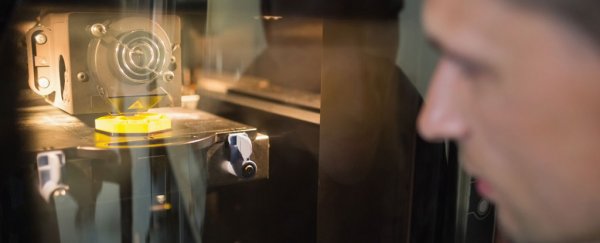We're constantly being told that 3D printing is going to change the world, and it's pretty easy to believe it will. The technology is already enabling all kinds of amazing things to be made on the spot, from dental braces to body parts and even the world's lightest material. This is all stuff we can use.
But a new discovery has revealed a fundamental security flaw in today's 3D printers. Researchers at the University of California, Irvine (UCI) say that by simply recording the noises a 3D printer makes while it's printing, it's possible to reverse-engineer the design of the object being produced.
The process works by listening to the noises a 3D printer makes to detect and track the movements of the printer's nozzle. You can then use this to work backwards and figure out the design it's following.
In other words, you could hypothetically steal the intellectual property of any product being 3D-printed, just by placing something like a smartphone beside the 3D printer as it operates. For lots of open-source toys, figurines, and trinkets that are publicly shared on the internet, that's not a problem, as many designs aren't intended to be kept secret.
But for other, more sensitive product blueprints that aren't meant to be shared, the mere sound of a 3D printer can give the game away.
"In many manufacturing plants, people who work on a shift basis don't get monitored for their smartphones, for example," said lead researcher Mohammad Al Faruque, director of UCI's Advanced Integrated Cyber-Physical Systems Lab. "If process and product information is stolen during the prototyping phases, companies stand to incur large financial losses. There's no way to protect these systems from such an attack today, but possibly there will be in the future."
Al Faruque's team stumbled on the discovery while examining the physics of 3D printing, looking at the relationship between information and energy flows. What they found, almost by accident, was that the distinctive whirring and buzzing of 3D printers isn't just extraneous noise.
"According to the fundamental laws of physics, energy is not consumed; it's converted from one form to another – electromagnetic to kinetic, for example," said Al Faruque. "Some forms of energy are translated in meaningful and useful ways; others become emissions, which may unintentionally disclose secret information."
In the case of 3D printers, the source code that instructs the machine – called G-code – can be encrypted, so you can physically 3D-print an object without getting access to its design information. But the loophole Al Faruque and his team discovered means there's no 3D-object source that can't be revealed by audio capture – at least to a significant degree.
Their findings – which are being presented next week at the International Conference on Cyber-Physical Systems in Vienna – detail how they were able use their noise-hacking approach to duplicate a key-shaped object with almost 90 percent accuracy. While the technique clearly doesn't enable an exact, perfect copy, for individuals or organisations who are seeking to prevent their designs from industrial espionage, there's plenty to think about.
The scientists suggest it might be possible to somehow jam the acoustic signals given off by 3D printers, perhaps by means of a white noise device that could prevent recordings, or by using an algorithm that somehow masks the printing process so as not to surrender design instructions. What's clear is that something will need to be done to ensure copy-protection in 3D printing in the future, or the whole industry could be held back.
"Initially, we weren't interested in the security angle, but we realised we were onto something, and we're seeing interest from other departments at UCI and from various US government agencies," said Al Faruque.
We don't doubt scientists will fix this security flaw, but until they do, all kinds of intellectual property could be exposed. So if you've had an amazing idea for a revolutionary new invention and you want to keep your design to yourself, it might not be a bad idea to hold off on 3D printing for now…
